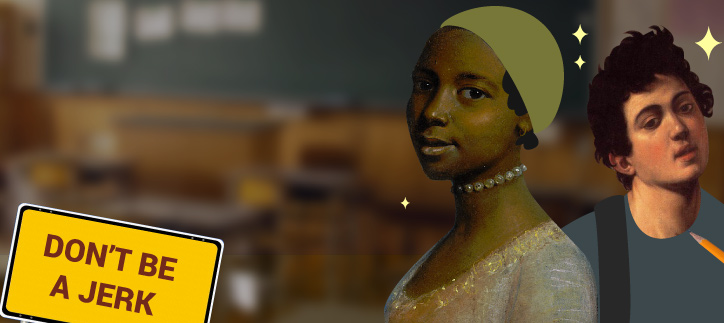Looking for more PBIS resources? Check out all of our Teacher Guides and Online Courses here.
Let's face it: America's colonial ancestors aren't exactly the best role models when it comes to tolerance and acceptance. In fact, the only "tolerance" they knew was the weird village woman named Tolerance (who lived with her sisters, Prudence, Patience, and Modesty).
Times (and names) have changed. Today more than ever, it's important to understand and accept cultures different from our own, even if they still have names you think are weird.
In this guide you will find
- an assignment based on Martin Luther King, Jr.'s "I Have a Dream" speech.
- resources on social justice movements based on race, gender, and sexual orientation.
- (admittedly uncomfortable) discussion questions about stereotypes and how they impact students' lives.
Yes, we know we said "uncomfortable." Keep in mind that the important discussions tend to be the hardest discussions. This teaching guide will help ease you and your students—even if they're named Tolerance or Temperance or Mercy—into the conversation.
DAY 1: NOW'S THE TIME
Introduction
Today, we are setting the foundations for a unit on acceptance and tolerance by tackling the notion of stereotype and exploring exactly how harmful stereotyping can be. Students will be looking at Martin Luther King, Jr.'s "I Have a Dream" speech and writing speeches of their own based on a stereotype they find particularly harmful.
Key Skills and Learning Objectives
- Learn the meaning of stereotype
- Discover how many stereotypes exist in our world
- Start thinking about how we can practice tolerance and acceptance by abolishing stereotypes
Homework
- Yesterday: Zilch.
- Today: Fill out "I Have a Dream" handout.
FREE AT LAST?
Materials Needed: Blackboard, four or five pieces of colored chalk, a camera, and access to Martin Luther King, Jr.'s "I Have a Dream" speech.
Estimated Time to Complete: 50 minutes
[Open class with showing the students the video of Martin Luther King Jr.'s speech "I Have a Dream" listed under materials. This video is long, but, as we believe every human being should watch it, don't feel bad dedicating a big chunk of class time to it.]
What is a stereotype? [Have students answer.] A stereotype is a widely held but oversimplified, and sometimes, if not always, hurtful, idea about a particular type of person or thing. What are some stereotypes about teenagers? What about adults? [Write the students' suggestions on the board. Examples might include: All teens are inconsiderate. All teens want to wear ripped clothes. All old people are forgetful. All adults are uptight, etc.]
Get into groups of four or five people and come up with a list of stereotypes you know exist. Try to write down at least ten. [Give the students ten minutes for this.] Now I want you to pick five of the most interesting stereotypes and come up here and write them on the board. [Have every student write a stereotype on the board (you can add one, too). Try to get as many students writing at once to save time. It shouldn't take long. After they have all written on the board, take a photo of it.]
Take a look at the board. How do these stereotypes make you feel? [Give students a chance to respond.] Do any of them hurt you? Do any of them make you angry? Pick the stereotype that you find the most hurtful, write it on your handout, then come up and erase it. [Give the students as much time as they need for this. They should come up one by one. Maintain silence during this exercise. After all the stereotypes have been erased, take a photo. (There should be smudge marks where the stereotypes were.) Feel free to erase one yourself, to kick things off.]
Martin Luther King, Jr. really believed in taking down stereotypes and letting people live and be treated as equals, and sadly, he ultimately died for this cause. For the rest of the class, I want each of you to get back in your groups and discuss the cons of stereotyping. Each group will be assigned a different type of stereotype to tackle:
- Race
- Religion
- Gender and sexuality
- Age and ability
Your discussion should cover the following questions: What kinds of stereotypes exist in your topic? Why are they harmful? How can we work to reduce stereotyping of this topic? Pick a person to take notes on the discussion, and hand them in at the end of class.
HOMEWORK
Write your own "I Have a Dream" speech based on the stereotype you erased on the board. Don't worry, it doesn't have to be as long (or as eloquent) as the original. Start with a statement of the problem at hand. For instance, "Glasses are an amazing invention that allow people to see, however, people who wear glasses are still seen as different than people who don't. Nerdy, smart, librarian-ish, and more are all assumptions that need to be demolished!" Then follow it up with eight "I have a dream…" statements. Here is Martin Luther King, Jr.'s transcribed speech for reference.
"I have a dream that students who wear glasses will not be asked to solve myriad math equations by every un-bespectacled peer in the class!"
DISCUSSION AND ESSAY QUESTIONS
- Has anyone ever assumed anything about you that was wrong? What was it? How did it make you feel?
- Do you think stereotyping exists at our school? Where?
- Do some stereotypes seem like they are not harmful? Which ones? How could they be harmful?
- Do you assume a person will be a certain way because of their race? How about their religion?
- Is it possible to reform someone who's super racist? How would you do it?
- What does tolerance mean to you?
- What is the difference between tolerance and acceptance?
- Are you intolerant toward anyone in your family, even slightly?
- What do you think the world would be like if we all looked exactly the same?
- Have you ever practiced tolerance and acceptance before? How did you do it?



